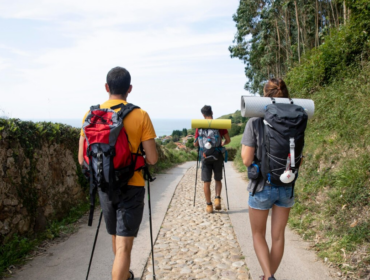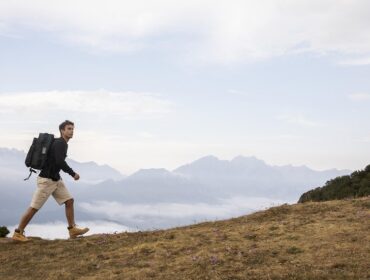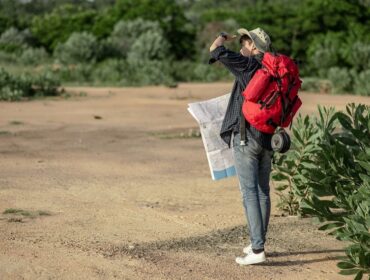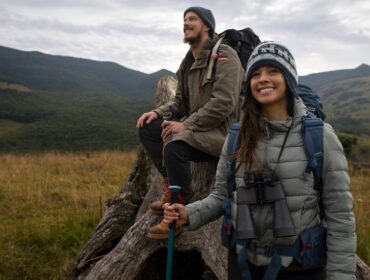As the seasons change, so does the opportunity for new adventures. If you’ve been hiking in the snow, you know it can be very difficult. One moment you’re on shallow snow and the next step takes you feet below your last stride. With snowshoes, you can hike in snowy conditions much more easily. Check out this beginner’s guide to snowshoeing to get you started.
What is Snowshoeing?
With snowshoes, any winter wonderland is hikable. The design of these outer footwear attaches to your winter boots to create a floatation mechanism above the snow. The wider area created by the shoes displaces the hiker’s weight to better maneuver across all types of snow.
The first snowshoes date back 6,000 years and resembled animal tracks such as hares. Throughout time, they have been a staple of survival in remote areas and many industries. Today, it’s one of the more accessible winter sports in a landscape of expensive gear and culture. However, snowshoeing is a great addition to many winter sports like skiing, snowboarding, mountaineering, snowmobiling, trail running and more.

How to Choose Snowshoes
Once you’re ready to find your perfect snowshoes, you’ll need to consider a few factors.
What type of snow will you be hiking in?
Snowshoes vary in size depending on the type of snow. Go for a smaller frame on hard and more packed snow. A larger frame is best for soft, powdered snow.
How much does your pack weigh?
Depending on the durations of your hikes, you’ll need to factor in the total weight you’ll be distributing once on your snowshoes. For example, if you’re backpacking, you will need to account for a much higher pack weight than if you’re just going on day hikes.
What kind of terrain will you be hiking?
Attempt to plan ahead, knowing the majority of terrain you’ll be hiking. There are different shoes for flat and mountainous terrain.
How to Dress and Pack for Snowshoeing
Just like any other winter hike, you’ll need to dress for the elements you’re anticipating and pack for the possibility of inclement weather. Be sure to wear winter layers and waterproof winter shoes or hiking boots. Also, be sure to pack for unexpected weather.
Waterproof hiking boots or shoes – This is a must. Soggy shoes will not only ruin your snowshoeing experience, they can also cause frostbite if not tended to. Snowshoes usually fit to any pair of shoes so you shouldn’t feel limited in finding the right pair that will keep you wam.
Wool socks – It’s best practice to bring an extra pair as well.
Sunglasses or goggles and sunscreen – The sun’s reflection off the snow can become more harmful than normal UV rays. Be sure to wear sunglasses with UV protection and sunscreen with a high SPF to avoid sunburn and snowblindness.
Waterproof gloves or mittens – Keep your temperature regulated with warm, waterproof gloves.
Beanie, hat or a balaclava – Similar to your hands, the temperature of your head regulates your total body temperature. Choose your headwear based on the conditions of your adventure: a billed cap for sunny days, beanie for later in the day, and or a balaclava for more extreme weather.
Gaiters – These attach to your boot or shoe of choice to keep the snow out of your boots and sock.
When it comes to your pack, you’ll want to plan for colder temperatures, which makes your packing list a little different than a summer hike. For example, don’t bring a hydration pack if you’ll be trekking in under-freezing conditions, as it will freeze. For a full list of gear you should bring, you can find out more here.

Equipment You Need to Snowshoe
In addition to winter attire, winter boots, and hiking poles, you’ll need to find the perfect pair of snowshoes for your adventures.
MSR Lightning Ascent Snowshoes 22 Cobalt Blue

These highly rated MSR Lightning Ascent snowshoes are ultralight and have aggressive all-terrain performance. The snowshoes’ 360 Traction Frames provide unrivaled grip-especially on traverses and ultimate comfort throughout.
Yukon Charlie’s Advanced Float Snowshoe Kit for Women

Designed specifically for women by women, these backcountry snowshoes are great for snow hiking and other winter adventures. These snowshoes deliver high performance under harsh conditions.
Atlas Range-MTN Snowshoes

Coming in at a higher price point, this premier, “go anywhere, do anything” snowshoe is in a class of its own. For a versatile snowshoe that’s at home on the trail, in the mountains, and everywhere in between, look no further than the Range-MTN.
Yukon Charlie’s Champion Snowshoe Kit

Yukon Charlie’s Champion Snowshoe Kit makes it easy to put on and take off. Its free float axle system moves with your natural stride so they will feel more comfortable whether hiking on a groomed trail or blazing your own.
Children’s Snowshoes
Yukon Charlie’s Penguin Molded Snowshoe Kit for Youth

This classic Yukon Charlie’s Penguin children’s snowshoes are perfect for adventurous kids looking for their first snowshoeing experience. They are made of ultra-lightweight and durable polypropylene that make them easy to use.
MSR Tyker Snowshoes for Kids

This is the kid-sized version of MSR’s strong, reliable Denali snowshoes. These easy-to-use snowshoes are intended for children who weigh up to 90 pounds.
Yukon Charlie’s V Frame Aluminum Snowshoe Kit

Add-Ons for More Comfortable Snowshoeing
MSR Flotation Tails For Evo Snowshoe

MSR’s Flotation Tails for Evo Snowshoe give you an extra six inches of on-demand flotation to any Evo snowshoe. This pair sets you up for added flotation in deep snow or when carrying a heavier pack.
How to Walk in Snowshoes
While it might look difficult to walk in snowshoes, with a little practice, it can become second nature in no time. If you’re a skier, the technique on the slopes will translate to snowshoeing.
Walking in snowshoes isn’t too challenging, simply walk as you normally would. But going long distances can feel much more tiresome than simply walking with boots on. Here are some tips:
- Lift your feet higher to take each step. You may not immediately notice the difference but, over time, you’ll start to feel more tired.
- You can’t walk backward. To combat this, remember to walk in a circle when you want to turn around.
- Consider your balance. Hiking poles with snow baskets help a lot as you distribute your weight on your snowshoes.
Safety Tips When Snowshoeing
Snowshoeing gives you the opportunity to go off trail and explore the winter in a new way. However, with the ability to go off path, you’ll want to make sure you’re prepared. It’s best practice to plan for an adventure you’re ready for and always bring the proper gear. This should include navigation, extra layers, plenty of water and snacks, and awareness of the area you’re adventuring. If you’ve ever been curious about snowshoeing, this is your sign to get out there and try it out for yourself.
Article by Christin Workman
Christin (she/her) is a writer and outdoor enthusiast. She’s a backpacker, hiker, ‘baby’ climber and a stop-and-smell-the-wildflowers kind of adventurer. Christin lives in Colorado with her husband, Rhodesian Ridgeback and a myriad of plants. When she’s not playing with words, she’s either out in backcountry, tending to the garden or practicing aerial arts.





